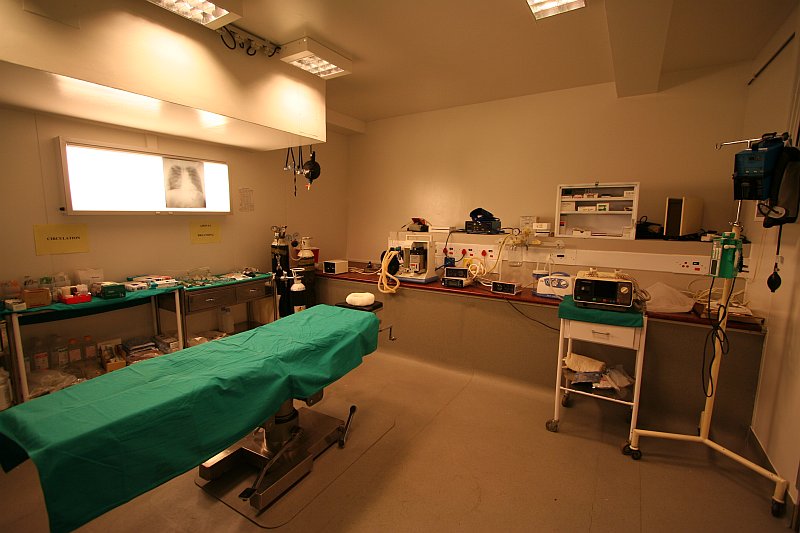SANAE Medical Facility
Although there are only 10 overwintering team members, SANAE IV is a large base, capable of supporting around 100 personnel during the summer period. Keeping everyone healthy and being ready to respond to medical emergencies in one of the harshest and most remote environments on the planet takes careful planning, and requires significant resources. In addition, South Africa carries a regional responsibility for search and rescue missions in Antarctica – SANAE IV needs to be ready to take on casualties in the event of a disaster. To this end, the medical facility is relatively large and includes a consulting room, clinic, full dental equipment, darkroom, pharmacy and operating theatre. The rooms interlink on the lower floor of the A-Block, adjacent to the radio room and expedition leader’s office.
First stop is the doctor’s office (above), with examination bed basic diagnostic equipment. In two cupboards (not visible in the photograph) I keep basic common medications, first aid supplies and the medical library. A jump-bag and additional emergency drug box stand ready to be grabbed in case of an emergency outside the base or evacuation.
The clinic area is the largest and central section of the medical complex, located between the doctor’s office and operating theatre, and connected to both by interleading doors. It includes a hospital bed and monitoring equipment for in-patient treatment (left side of photo) as well as most of the specialised diagnostic equipment. At SANAE we have a mobile x-ray machine (bottom left), allowing he doctor to take x-rays which are developed in the nearby darkroom. A centrifuge and microscope allow tissue, blood and urine samples to be examined. A special machine known as a “Reflotron” allows blood investigations such as serum electrolytes, haemoglobin, and serum enzymes to be ascertained. Cell counts and stains have to be done manually using the microscope. An autoclave allows sterilisation of all but the largest diagnostic and surgical equipment. Leading off from the clinic area is a small annex with a toilet for patients as well as a large bath (one of only two at the base) used for hypothermia treatments.
The dental equipment (right side of photo) is also to be found in the clinic area, clustered around the dentist’s chair. A dental platform with pneumatic drills (both slow and fast hand drills) is driven by a separate compressor, which also provides water and pressurised air supply. A separate suction unit completes the system. Supplies and equipment are available to enable the doctor to perform prophylactic procedures like fluoride treatment as well as curative interventions like fillings, root canals, bridge and denture repairs.
In the centre of the picture above, to the right of the theatre doors, stands a green box atop the fridge. This is a genuine field medical trunk preserved from the 1957 Trans-Antarctic Expedition (which included Sir Edmund Hillary, and the first SANAE expedition leader, Hannes le Grange).
SANAE IV’s operating theatre is situated at the end of the medical facility, leading off the clinic area. Although Spartan in appearance it is equipped to perform most types of emergency surgery. Resuscitation equipment (left side of photo) is arranged by a system to allow all team members to assist the doctor swiftly. A small anaesthetic machine, ventilators, monitors, defibrillator and electocautery/electrosurgical system stand at the ready. Emergency drugs and fluids are kept at hand in a small secure cabinet. Oxygen and nitrous oxide supply is provided via a piped system, but spare cylinders are also at hand. While no doctor would desire to perform an anaesthetic and operation simultaneously alone, we are equipped to allow craniotomy, thoracotomy, laparotomy, vascular and basic orthopaedic procedures to be performed should the need arise. We even have equipment to perform skin grafts and rigid endoscopy.
Medical gasses (oxygen and nitrous oxide) for the medical facility are supplied via a pipeline system from the gas supply niche, pictured above. The tanks need to be exchanged yearly during the take-over period.
Still to come – the pharmacy/medical store and dark-room.



